Reviewed by Danielle Ellis, B.Sc.Jan 17 2024
Each cell’s nucleus contains DNA, which is the blueprint for human life.

Image Credit: Billion Photos/Shutterstock.com
About six and a half feet of this genetic material must be compressed in human cells in order for the nucleus to fit inside. Condensation of DNA is not random. For the genetic material to work correctly, it must be highly organized into loop structures, which frequently connect widely separated regions of the genome that are essential for controlling gene activity.
Scientists from Oliver Bell's lab at USC Stem Cell discuss how these loops can help suppress or silence gene activity, with potentially profound effects on human health, in a recent paper published in Nature Communications.
A carefully orchestrated regulatory machinery is required to ensure every cell in the body is expressing its correct gene set to exert its dedicated function.”
Daniel Bsteh, First Author and Researcher, Institute of Molecular Biotechnology, Austrian Academy of Sciences
Bsteh completed the research at the Keck School of Medicine of USC during PhD. Bsteh is currently the Liquid Biopsy Core Manager at the USC Norris Comprehensive Cancer Center.
Bsteh and associates specifically investigated developmental genes in the study that are suppressed by molecules called Polycomb Repressive Complexes 1 and 2 (PRC1 and PRC2). Regulators PRC1 and PRC2 stop developmental genes from activating in the wrong cell or at the wrong time, which has been demonstrated to alter cellular identity and result in malignant cell transformation.
The genome forms loops when PRC1- and PRC2-repressed genes combine. Although the function of loops in gene activation is well established, investigating the potential role of loops in gene repression has proven more difficult. This is due to loops' interdependence with histone modifications, a distinct kind of gene repression mechanism.
By using mouse embryonic stem cells for a genetic screen, the researchers discovered PDS5A, a protein that alters loops but not histone modifications. This made it possible for Bsteh and associates to investigate the effects of loops and three-dimensional genome organization on the silencing of genes.
The long-range interactions between repressed developmental genes were disrupted by the loss of PDS5A, which also affected the loops. Moreover, the silent state is preserved by looping genes together. Normally silent genes become aberrantly activated when PRC1- and PRC2-repressed genes are physically separated, removing the loops.
PDS5A is a subunit of a larger protein complex called cohesin, which is the master regulator of 3D genome organization. Cohesin mutations are known to drive several human diseases, including developmental disorders and cancer. What’s striking about our discovery is that it reveals a dependence of PRC 1 and PRC 2 activity on the precise regulation of 3D genome organization by cohesin, suggesting that ‘cohesinopathies’ may be linked to aberrant developmental gene silencing.”
Oliver Bell, Member, USC Norris Comprehensive Cancer Center
Oliver Bell is also an Assistant Professor of Biochemistry and Molecular Medicine and Stem Cell Biology and Regenerative Medicine
Source:
Journal reference:
Bsteh, D., et al. (2023) Loss of cohesin regulator PDS5A reveals repressive role of Polycomb loops. Nature Communications. doi.org/10.1038/s41467-023-43869-w